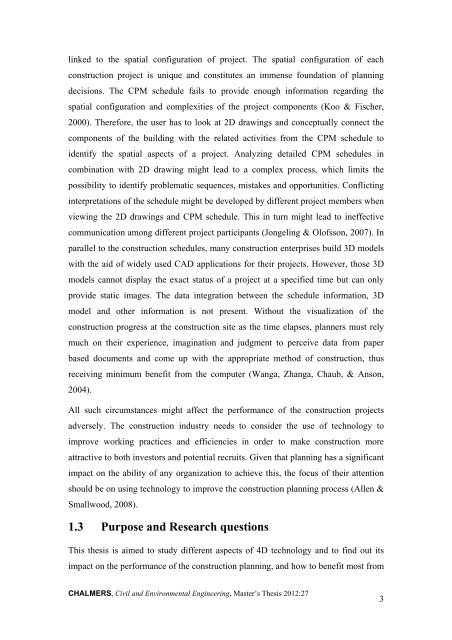impact of 4d modeling on construction planning process - Chalmers ...
impact of 4d modeling on construction planning process - Chalmers ...
impact of 4d modeling on construction planning process - Chalmers ...
You also want an ePaper? Increase the reach of your titles
YUMPU automatically turns print PDFs into web optimized ePapers that Google loves.
linked to the spatial c<strong>on</strong>figurati<strong>on</strong> <str<strong>on</strong>g>of</str<strong>on</strong>g> project. The spatial c<strong>on</strong>figurati<strong>on</strong> <str<strong>on</strong>g>of</str<strong>on</strong>g> each<br />
c<strong>on</strong>structi<strong>on</strong> project is unique and c<strong>on</strong>stitutes an immense foundati<strong>on</strong> <str<strong>on</strong>g>of</str<strong>on</strong>g> <strong>planning</strong><br />
decisi<strong>on</strong>s. The CPM schedule fails to provide enough informati<strong>on</strong> regarding the<br />
spatial c<strong>on</strong>figurati<strong>on</strong> and complexities <str<strong>on</strong>g>of</str<strong>on</strong>g> the project comp<strong>on</strong>ents (Koo & Fischer,<br />
2000). Therefore, the user has to look at 2D drawings and c<strong>on</strong>ceptually c<strong>on</strong>nect the<br />
comp<strong>on</strong>ents <str<strong>on</strong>g>of</str<strong>on</strong>g> the building with the related activities from the CPM schedule to<br />
identify the spatial aspects <str<strong>on</strong>g>of</str<strong>on</strong>g> a project. Analyzing detailed CPM schedules in<br />
combinati<strong>on</strong> with 2D drawing might lead to a complex <strong>process</strong>, which limits the<br />
possibility to identify problematic sequences, mistakes and opportunities. C<strong>on</strong>flicting<br />
interpretati<strong>on</strong>s <str<strong>on</strong>g>of</str<strong>on</strong>g> the schedule might be developed by different project members when<br />
viewing the 2D drawings and CPM schedule. This in turn might lead to ineffective<br />
communicati<strong>on</strong> am<strong>on</strong>g different project participants (J<strong>on</strong>geling & Ol<str<strong>on</strong>g>of</str<strong>on</strong>g>ss<strong>on</strong>, 2007). In<br />
parallel to the c<strong>on</strong>structi<strong>on</strong> schedules, many c<strong>on</strong>structi<strong>on</strong> enterprises build 3D models<br />
with the aid <str<strong>on</strong>g>of</str<strong>on</strong>g> widely used CAD applicati<strong>on</strong>s for their projects. However, those 3D<br />
models cannot display the exact status <str<strong>on</strong>g>of</str<strong>on</strong>g> a project at a specified time but can <strong>on</strong>ly<br />
provide static images. The data integrati<strong>on</strong> between the schedule informati<strong>on</strong>, 3D<br />
model and other informati<strong>on</strong> is not present. Without the visualizati<strong>on</strong> <str<strong>on</strong>g>of</str<strong>on</strong>g> the<br />
c<strong>on</strong>structi<strong>on</strong> progress at the c<strong>on</strong>structi<strong>on</strong> site as the time elapses, planners must rely<br />
much <strong>on</strong> their experience, imaginati<strong>on</strong> and judgment to perceive data from paper<br />
based documents and come up with the appropriate method <str<strong>on</strong>g>of</str<strong>on</strong>g> c<strong>on</strong>structi<strong>on</strong>, thus<br />
receiving minimum benefit from the computer (Wanga, Zhanga, Chaub, & Ans<strong>on</strong>,<br />
2004).<br />
All such circumstances might affect the performance <str<strong>on</strong>g>of</str<strong>on</strong>g> the c<strong>on</strong>structi<strong>on</strong> projects<br />
adversely. The c<strong>on</strong>structi<strong>on</strong> industry needs to c<strong>on</strong>sider the use <str<strong>on</strong>g>of</str<strong>on</strong>g> technology to<br />
improve working practices and efficiencies in order to make c<strong>on</strong>structi<strong>on</strong> more<br />
attractive to both investors and potential recruits. Given that <strong>planning</strong> has a significant<br />
<str<strong>on</strong>g>impact</str<strong>on</strong>g> <strong>on</strong> the ability <str<strong>on</strong>g>of</str<strong>on</strong>g> any organizati<strong>on</strong> to achieve this, the focus <str<strong>on</strong>g>of</str<strong>on</strong>g> their attenti<strong>on</strong><br />
should be <strong>on</strong> using technology to improve the c<strong>on</strong>structi<strong>on</strong> <strong>planning</strong> <strong>process</strong> (Allen &<br />
Smallwood, 2008).<br />
1.3 Purpose and Research questi<strong>on</strong>s<br />
This thesis is aimed to study different aspects <str<strong>on</strong>g>of</str<strong>on</strong>g> 4D technology and to find out its<br />
<str<strong>on</strong>g>impact</str<strong>on</strong>g> <strong>on</strong> the performance <str<strong>on</strong>g>of</str<strong>on</strong>g> the c<strong>on</strong>structi<strong>on</strong> <strong>planning</strong>, and how to benefit most from<br />
CHALMERS, Civil and Envir<strong>on</strong>mental Engineering, Master’s Thesis 2012:27<br />
3















